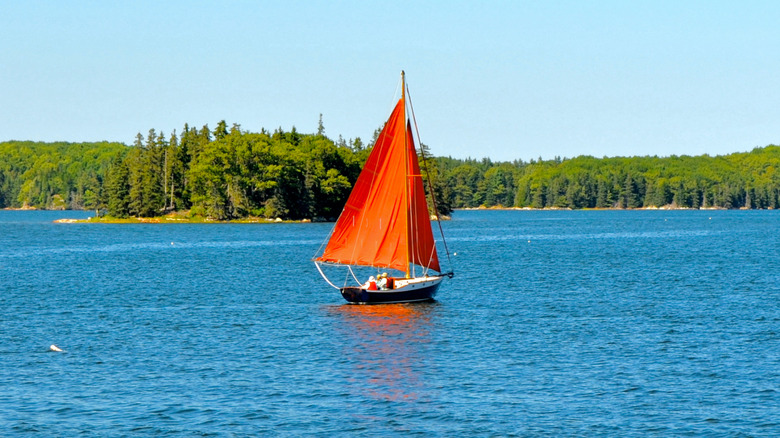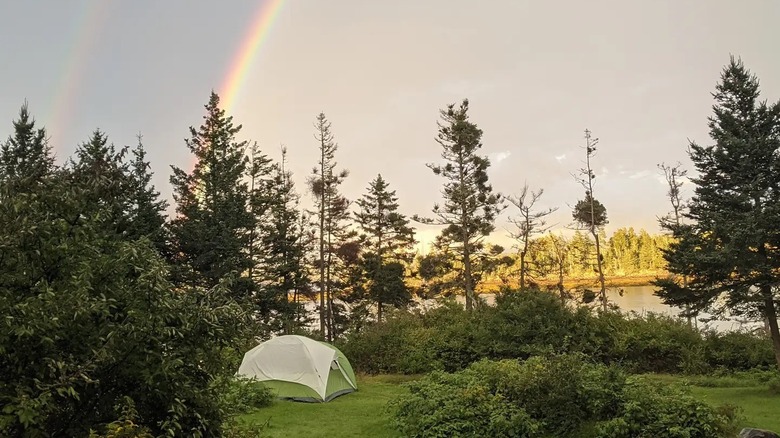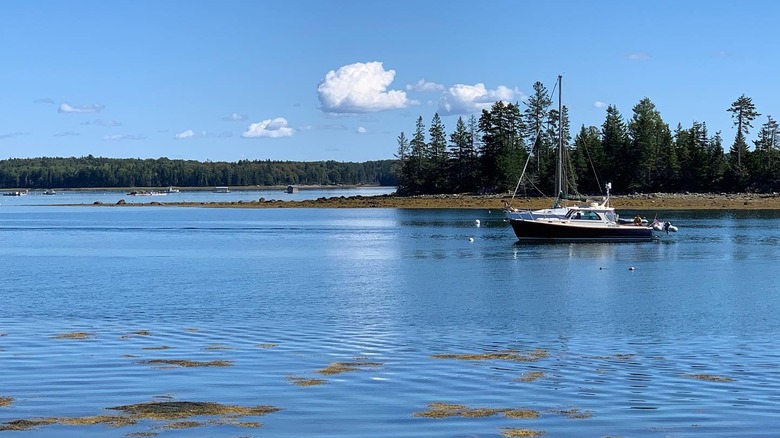One Of Maine's Most Remote State Parks Is A Pristine Island With Scenic Views And Secluded Campsites
As the largest state in New England, much of Maine is pretty remote, and its landscape is surprisingly varied. For example, maybe you didn't know that the state has a whimsical, family park called the Desert of Maine, featuring rolling sand dunes. While many spend summers at Acadia National Park, where an inlet with thundering waves is one of its most popular spots, few know about places like Warren Island State Park, located in Penobscot Bay about halfway down Maine's coastline. As a quiet spot with spruce trees and coastal wildlife, Warren Island State Park is most known for its camping. It was named one of the best places to camp in Maine by Down East Magazine, and you can even camp right by the sea.
Part of the reason Warren Island is so isolated is because of its lack of transportation to get to the island. There are no bridges or public transportation that connect to the island, so visitors need to take their own boat or a private ferry to reach it. To the boating enthusiast, though, this is part of Warren Island's appeal. Warren Island State Park is the first of its kind in Maine, designed intentionally for boat lovers. The island is encircled by coves and small islands that are perfect to explore by kayak or canoe. On land, come for the ocean sunsets, secluded beaches, and a hiking trail rustling with shorebirds and deer.
Camp at a quiet seaside spot in Warren Island State Park
At a unique crossroads between spruce forest landscapes and the Atlantic Ocean, camping at Warren Island State Park is a rare experience. The park has 12 campsites and three Adirondack shelters, all spread across the island and with plenty of privacy. Each site has its own picnic table and fire pit. There's also fresh drinking water and toilets available, but no electricity. A walking path connects all the campsites to each other and to a nice day area that has picnic spots and a small beach great for swimming.
The island itself spans 70 acres. Today, it's uninhabited, but at one time, in the late 1800s, it was home to one of the most expensive log cabins in New England and various family residences. Some remains from these 19th-century homes — and even a gravestone — can be found near the campsites and along the hiking trail. A single route winds across the island for about 1.5 miles, taking you through the spruce woodlands and along the ocean, where you're likely to see coastal birds like ospreys, blue herons, and loons. Kayaking is a top-tier activity at Warren Island, whether you're camping or just taking a day trip. One option is to paddle through Gilkey Harbor, where you can get views of the Grindle Point Lighthouse and search for otters or even moose going for a swim.
How to get to Maine's Warren Island State Park
The most complicated part of visiting Warren Island State Park is getting there. Though if you love boating, it'll be a highlight of the trip. In short, you have two options: sail your own boat from the mainland or neighboring Islesboro or take a chartered water taxi. The first option is the simpler and less expensive choice. If you have your own boat, kayak, or canoe, you can launch it from Lincolnville on the mainland for a roughly 3.3-mile trip across the bay to Warren Island. Lincolnville is about an hour's drive from Maine's Bangor International Airport.
If you're not comfortable with boating (or have little ones who would be safer with a chartered boat), you can take the Margaret Chase Smith ferry from Lincolnville to Isleboro, taking about 20 minutes. From Isleboro, there's at least one private boat service offering trips to Warren Island State Park: Quicksilver Water Taxi. Isleboro is also a great stop to stock up on gear and food, and Bluewater Bakery is a lovely breakfast and lunch restaurant on the island.
When you arrive at Warren Island, you have to register at the Visitors Information Center kiosk. There's one main dock on the island, though you can also paddle straight to your camping site — just be careful during low tide, as walking from the shore to your site can be slippery. The park is open from May through September, so you should plan your trip based on the best time to visit Maine for your interests.


